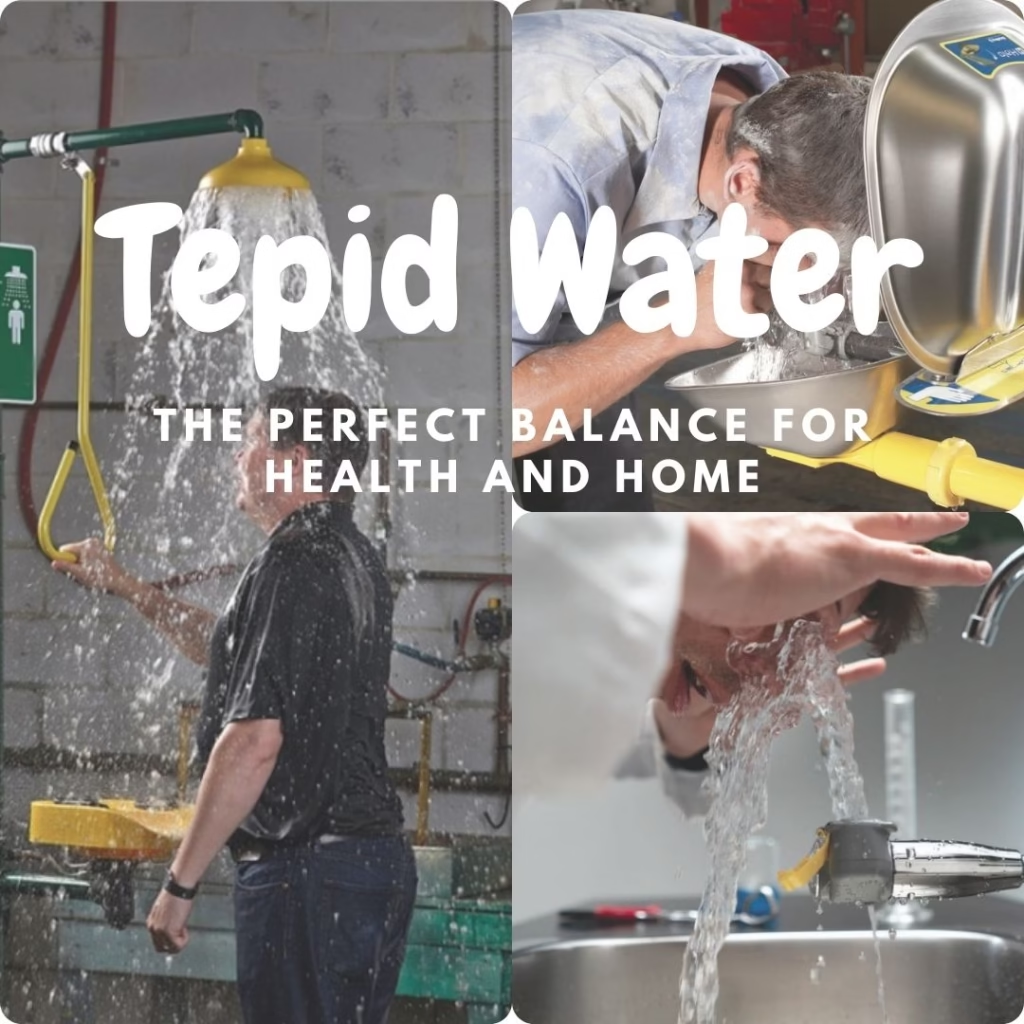Tepid water, generally ranging between 60°F and 100°F (16°C to 38°C), is a moderate temperature that feels neither cold nor hot. This mild warmth is especially valued for its versatility in various settings, including health care, culinary tasks, and household chores. In health, it is gentle on the body, making it ideal for wound cleaning and relaxation. In cooking, it’s perfect for activating yeast and preparing certain dishes. This accessible temperature can enhance daily routines by improving comfort, safety, and efficiency in tasks requiring water.
What is Tepid Water?
Water hotter than 100°F (38°C) can lead to scalding injuries, exacerbating any existing wounds. High-temperature water can cause burns, resulting in pain, skin damage, and a heightened risk of chemical absorption through the skin. Conversely, using cold water below 60°F (16°C) can cause discomfort. In severe cases, exposure to cold water can lead to hypothermia, which poses serious health risks and can be life-threatening.
Tepid water is defined as water that is neither too hot nor too cold, usually falling within a temperature range of 60°F to 100°F (16°C to 38°C). This range is selected for its balance of comfort and safety, making it particularly suitable for various applications, especially in emergencies involving hazardous chemicals.
It is often confused with lukewarm water, and the two terms are sometimes used interchangeably. However, lukewarm water typically refers to a slightly narrower range, centered around body temperature, usually between 98°F and 105°F (36.5°C to 40.5°C), which is marginally warmer than tepid water. Additionally, it differs from room temperature water, which is water that has naturally reached the ambient temperature of its surroundings and is often preferred for drinking.
Summary:
- It is maintained within a temperature range of 60 to 100°F (16 to 38°C).
- It plays a crucial role in emergencies involving exposure to hazardous chemicals.
- This water should not be mistaken for lukewarm water.
- Lukewarm water is slightly warmer than tepid water.
- It is distinct from room-temperature water.
- Room temperature water varies based on the specific conditions of the surrounding environment.
Common Uses of Tepid Water
Using water that is either too hot or too cold can lead to serious consequences. Understanding the appropriate water temperature is crucial for ensuring both safety and comfort. This is why this water is often the preferred choice and, in many cases, essential for various applications.
Medical Uses
It is frequently used for wound cleaning, bathing, and general healthcare in medical settings. Its gentle temperature makes it ideal for delicate care, helping to cleanse wounds without causing additional irritation. This makes it a preferred choice for patients who require soothing treatment.
Industrial Applications
In industrial environments, tepid water is commonly found in safety showers designed to prevent shock. By providing a controlled temperature, these showers ensure that workers can wash off hazardous substances safely and effectively, minimizing the risk of thermal shock and enhancing overall safety. Tepid water is essential for emergency eyewashes and safety showers. This temperature range minimizes the risk of thermal shock or adverse chemical reactions that can arise from extreme temperatures. For example, suppose a worker is exposed to hazardous chemicals. In that case, tepid water facilitates effective rinsing without causing additional harm or discomfort, encouraging the individual to wash away the dangerous substance thoroughly.
Culinary Uses
In the culinary world, tepid water is essential for various processes, including proofing yeast, which is crucial for bread-making. The moderate temperature activates the yeast without killing it, ensuring that the dough rises properly. Additionally, tepid water is often used in tea preparation, as it allows for the optimal extraction of flavors without scalding the leaves.
Personal Care
Tepid water offers numerous benefits for personal care, particularly for skin and hair. Its gentle warmth helps cleanse effectively without stripping natural oils, making it suitable for washing the face or bathing. This temperature is particularly beneficial for sensitive skin, providing a soothing experience.
Household Applications
In household settings, tepid water is useful for a variety of washing and cleaning tasks. Its ability to mix solutions effectively makes it ideal for diluting cleaning agents and preparing cleaning solutions. Whether you’re doing laundry or cleaning surfaces, tepid water can enhance the effectiveness of your cleaning routine.
Scientific Properties
Thermal Characteristics
This water is energy-efficient because it requires significantly less energy to heat compared to hot water. This makes it an eco-friendly option, reducing energy consumption and promoting sustainability in various applications.
Effects on Materials
Using this water minimizes the risk of damaging materials. Its moderate temperature is less likely to cause warping, cracking, or other forms of deterioration, making it ideal for delicate surfaces and sensitive components. This ensures longevity and maintains the integrity of materials during cleaning or processing.
Health Benefits of Tepid Water
Tepid water has been recognized for its various health benefits, particularly in managing fever and enhancing overall well-being. Research indicates that its applications, such as sponge baths, can effectively reduce body temperature in children with fever, demonstrating significant therapeutic potential (Puspitasari et al., 2022, Fajarwati et al., 2023). In cases of dengue fever, tepid water therapy effectively manages hyperthermia (Fajarwati et al., 2023). Additionally, hydrotherapy, which includes the use of water at varying temperatures, has been shown to alleviate conditions like stress, pain, and even premenstrual syndrome (Yıldırım et al., 2022, Chowdhury et al., 2021).
Hydration
It is more palatable and easier to consume in larger quantities, making it an effective choice for improving overall hydration. Staying well-hydrated is essential for maintaining bodily functions, and drinking this water can encourage you to meet your hydration goals throughout the day. Furthermore, it is ideal for hydration before exercise and soothing muscles afterward, it provides a comfortable hydration experience for athletes.
Digestion
It supports digestion and metabolism by providing a soothing temperature that doesn’t shock the body. It aids in breaking down food more efficiently, promoting better nutrient absorption. Drinking water in this temperature range before or after meals can enhance digestive comfort and help maintain a healthy digestive tract.
Thermoregulation
This water plays a vital role in gently regulating body temperature. By drinking it, you can help maintain a stable internal temperature, especially during physical activity or in warm environments. This gentle approach to thermoregulation can prevent overheating and promote overall comfort, making it an ideal choice for hydration in various situations.
Challenges and Solutions for Tepid Water Provision
The specific temperature range of this water strikes a balance between hot and cold, making it essential for various applications, from industrial safety to personal care. However, achieving and maintaining the ideal tepid temperature can be challenging due to factors such as climate, urgency, and accessibility. Let’s explore the solutions to these challenges across different settings.
| Setting | Challenge | Solution |
| Industrial (e.g., manufacturing plants, laboratories) |
Keeping the water within the tepid range of 60°F to 100°F can be challenging, particularly in extreme climate conditions. | Implementing thermostatic mixing valves or temperature control systems allows for the precise mixing of hot and cold water to achieve the desired temperature. |
| Emergency Situations:
Quick access to tepid water is essential in cases of chemical exposure or accidents. |
Strategically Placed Stations:
Positioning emergency eyewash and shower stations at critical locations where accidents are more likely to occur. |
|
| Medical/First Aid (e.g., hospitals, clinics) |
Hygiene and Safety:
Preventing contamination and keeping water clean while maintaining the tepid temperature range. |
Regular Maintenance and Monitoring:
Adopting strict maintenance protocols and regularly monitoring water quality and temperature. |
| Immediate Availability:
Rapidly providing this water in urgent care situations. |
On-Demand Water Heaters:
Utilizing on-demand water heaters or instant heating systems to deliver tepid temperature immediately. |
|
| Personal Care (e.g., homes, salons) |
Accurate Temperature Control:
Reaching the exact tepid temperature for activities such as bathing infants or caring for hair. |
Thermostatic Faucets:
Employing faucets equipped with built-in thermostats to enable accurate temperature settings. |
| Energy Efficiency:
Finding a balance between the need for tepid water and energy conservation. |
Energy-Efficient Systems:
Installing energy-efficient water heaters and encouraging manual mixing of hot and cold water to reach the tepid temperature. |
Conclusion
In conclusion, tepid water, with its comfortable temperature range of 60°F to 100°F (16°C to 38°C), serves a crucial role across various domains, including healthcare, culinary practices, and everyday household tasks. Its gentle warmth makes it ideal for wound care, enhances cooking processes like yeast activation, and provides a soothing experience for personal care routines. Moreover, it is essential in emergency situations, offering safety and comfort without the risks associated with extreme temperatures.
While achieving and maintaining the ideal tepid temperature can present challenges, such as climate variability and urgent demands, practical solutions like thermostatic mixing valves and on-demand water heaters can help ensure consistent availability. By embracing the benefits of it, we can enhance our daily routines, promote safety in industrial settings, and support overall well-being. As we continue to recognize its value, it stands out as a versatile and essential resource in our lives.
FAQs
- What is tepid water?
It ranges between 68°F and 100°F, mild and comfortable for various uses. - Why use tepid water?
It’s gentle, making it suitable for medical, personal care, and culinary applications. - Is tepid water the same as warm water?
It is slightly cooler than warm water, balancing between cool and hot. - How do I make tepid water?
Mix hot and cold water or use a thermometer to measure the temperature. - Can tepid water help with hydration?
Yes, it’s easier to drink in large quantities than very hot or cold water. - What are the health benefits of tepid water?
It aids digestion, supports hydration, and helps regulate body temperature. - Is tepid water safe for cleaning?
Yes, it’s safe and effective for cleaning dishes, laundry, and mixing solutions. - Can I use tepid water for my plants?
Yes, it is ideal for most plants, as it avoids shocking the roots. - What are the cultural uses of tepid water?
It’s common in tea rituals, bathing practices, and health traditions globally. - Does tepid water save energy?
Yes, heating water to a tepid level consumes less energy than hot water.
Visit our recent posts
Thanks for reading, for more interesting articles, visit our homepage.








Pingback: Are Birds Mammals? Understanding Animal Classifications